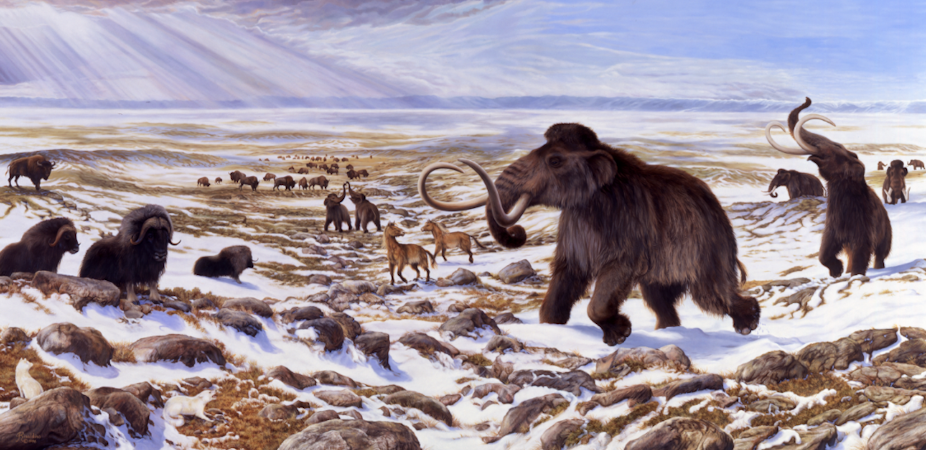When we think of the last 50,000 years of prehistory, particularly the “Ice Age”, extinct species such as the woolly mammoth and woolly rhinoceros often spring to mind.
Did humans bring about the extinction of these large animals (megafauna)? Or did they succumb to the impacts of a changing climate? And how did other megafauna, such as the elephant and reindeer, manage to survive?
These questions have troubled biologists for the past two centuries. They have also been the subject of heated debate in Australia, which has lost impressive species such as the diprotodon (a hippo-sized wombat) and giant versions of modern-day marsupials.
For many of the species that went extinct in the past few hundred years – including the New Zealand moa and the Malagasy elephant birds – there is overwhelming evidence that human activity caused their demise.
In other parts of the world, megafaunal extinctions roughly coincided with the arrival of humans. But coincidence is not proof of causation.

The disagreement has persisted because researchers have had differing interpretations of scant evidence. Many of the megafaunal species went extinct long ago, leaving few traces in the fossil and archaeological records.
Thanks to the huge progress in methods for genetic analysis, it is now possible to look at populations of extinct animals by studying DNA from ancient specimens. This DNA contains signatures of past changes in population size. These can be used to look at ancient populations and to see how they changed through time.
Bringing the evidence together
In an article recently published in Nature, my colleagues and I studied megafaunal extinctions by focusing on six species. These included the woolly mammoth, woolly rhinoceros, steppe bison, muskox, wild horse, and reindeer.
We chose to look at the Northern Hemisphere, where the permafrost has preserved huge numbers of specimens for us to analyse.
Our team of geneticists, archaeologists, and zoologists assembled the largest data set of its kind. The study involved nearly 10,000 radiocarbon dates and over 800 DNA sequences.
Apart from reconstructing the populations of the six species, we were able to evaluate the likely effects of humans by estimating their geographical overlap with the megafauna. The interaction between humans and the six species was assessed by the presence of megafaunal remains in archaeological sites.

Using estimates of the timing of changes in populations, we were able to examine the impact of changes in climate. For example, the population size of North American bison experienced a drastic decline during the height of the last Ice Age, when their habitat would have been greatly reduced.
We found that the decline of the woolly rhinoceros and musk ox could be explained entirely by changes in climate. It is likely that human expansion contributed to the demise of the steppe bison and wild horse – the two most common megafaunal species found in archaeological sites.
The reindeer has thrived to the modern day, but we could not find a clear cause for the extinction of the woolly mammoth.
Overall, our study shows the six species varied considerably in their responses to human impacts and changing climate. This suggests the causes of extinction can be complex and probably differ among species.
Megafaunal extinctions in Australia
It is unlikely we will ever be able to conduct such a comprehensive study on the extinctions in Australia. Good specimens are scarce and DNA degrades quickly in Australian conditions.

It has been difficult to place reliable dates on the megafaunal extinctions in Australia. This is because human colonisation and many of the extinction events occurred around 50,000 years ago, which is at the upper limit of radiocarbon dating.
The arrival of humans signalled a drastic change in the Australian environment, not just because of hunting, but also because of the extensive use of fire. This would have altered vegetation and the distributions of habitats.
Our chances of determining the causes of these extinctions will improve with progress in dating methods and ancient DNA analysis. Further refinement of the timing of human arrival in Australia will also be helpful.
Lessons for the future
Humans are now modifying the environment and the atmosphere at an alarming pace. This raises grave concerns about the future of the planet’s biodiversity. Many of the present-day megafaunal species are under threat and require careful management.
If there are any lessons to be learnt from our study of the megafaunal extinctions, it is that different species respond differently to the pressures of human hunting and encroachment, habitat redistribution, and changing climate.
This presents a challenge for conservation efforts because it can be difficult to predict the course of modern animal populations.

